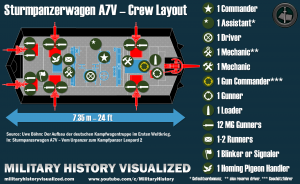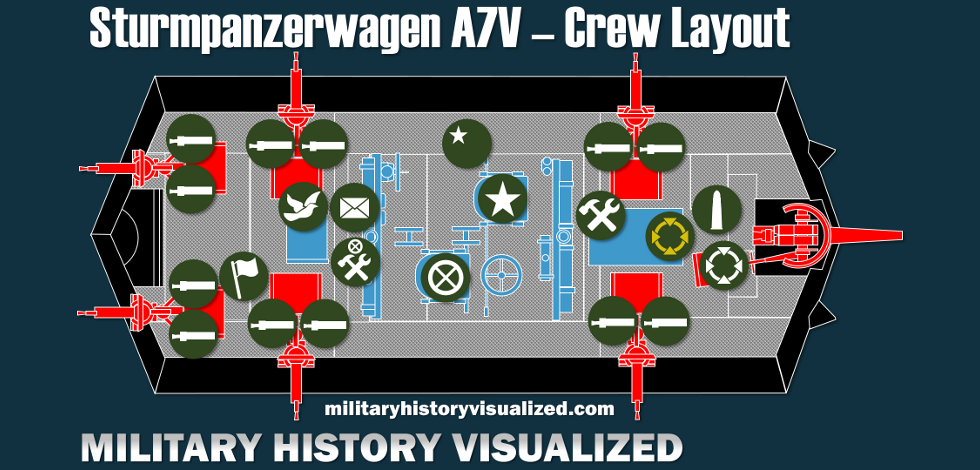Please note: This post contains amazon affiliate links. As an Amazon Associate I earn from qualifying purchases.

Introduction
The A7V or “Sturmpanzerwagen A7V” was the first German Tank and saw action in the later stages of the First World War. The rather unusual name of the tank was directly derived from a transport department in the war ministry, notably the department 7. (Abteilung 7 Verkehrswesen) (S. 54/2). The A7V was not only the first German tank, it was also the first fully-tracked built vehicle in Germany itself.
In total only 23 were built, 2 of them prototypes, one with a wooden superstructure and one with armor plates. 1 radio variant (S. 76) and 2 production runs with 10 tanks each. Now these low numbers are important to consider if someone makes any assessment about it, because the tank gained a very bad reputation that doesn’t seem to be justified, but more on that later.
Tanks in World War I
Tanks in World War I were quite primitive and a completely new technology. A tank was basically a slowly moving pillbox with guns due to the limits in mobility, reliability, range, doctrine and command capabilities. Tanks were first and foremost an infantry support weapon and even after various technological improvements and years later this was still a common view until the successes of German Panzer Forces in early stages of World War II.
Development
The development of the A7V involved 13 companies and the production 20 due to the complexity of a tank compared to other weapon systems.(S. 14 / 2) The rather fast development of 11 months could only be achieved due to the fact that a large amount of components were already available in the various industries.(S. 15 / 1) The weapons were standard equipment, the armor plates were similar to those used on warships. Yet, the available engines weren’t sufficient in terms of horse power, thus a twin engine plant of production-ready engines was used.
Production
Although the tank was developed quite fast, the overall process of development and production was not straightforward at all. After the initial appearance of Allied tanks on the Battlefield in 1916 the German High Command was convinced of the tank as an important weapon. Yet, this view changed, after the following limited success of the Allied tanks. This restricted the development and production of German tanks and the allocation of resources. Especially since the highest priority was given to submarine warfare. Yet, after the success of British tanks at the Battle of Cambrai in 1917, the German High Command (in end of 1917 (November)) pushed again for the introduction of German tanks. Yet, instead of pouring all resources in the A7V project, many new projects were started that didn’t reach a sufficient production readiness before the end of the war. The change in requirements, resource shortages, changing priorities, shifting interests and the usual bureaucracy delayed ultimately the production of the A7V in significant numbers. (S. 60 & 61) Although it should be noted that even a larger number of these wouldn’t made a difference in the outcome of the war due to the lack of fuel and other crucial resources.
Technical Specifications
Now let’s take a look at some technical specifications:
In this case, I had a great and detailed source co-written by German historians and engineers, which you can clearly see, because the provided the values in millimeters, because everyone knows centimeters or even meters aren’t precise enough when you are German and dealing with the measurements of a 30 ton tank.
The length was 7.35 m (7350 mm) with a width of 3.06 m (3060mm) and height of3.35m (3350 mm). The ground clearance was 0.2 m (200 mm) and a track width of 2.115 m (2115mm). This is especially interesting or crazy, because the tanks were not of identical construction.
It could traverse trenches up to 2 m in width, cross water at a depth of 0.8 m. Climb a vertical obstacle of up to 0.4 m and a climb a slope at 25 degree.
The maximum achieved speed was 16 km / h.
With two fuel tanks each with 250 liters, it had a range of about 30 to 35 km cross country and 60 to 70 km on roads.
Weight of the vehicle with fuel was 16 tons
The weight of the armor was 8.5 tons.
The weapons with ammo made up 3.5 tons.
And the crew with equipment another 2 tons, thus a total weight of 30 tons.
You probably gonna wonder, why you need about 2 tons for the crew and their equipment. Well, that is because the A7V had a crew of just about 16 to 26 men. In comparison a British Mark V tank had about 8 men.
Weapons & Armor
In terms of protection it had a frontal armor of 30 mm, at the side and rear the armor plates had a thickness of 15mm. The top plates were 6mm thick. In comparison the British Mark V had a maximum frontal armor of 16 mm.
The armament consisted of a 57mm Maxim-Nordenfelt gun which was mounted in the front and two 08/15 machine guns for each side and the rear. A large amount of amount of ammo was carried, initially 180 rounds for the 57mm gun, this value was later increased to around 300. The number of MG rounds was about 18 000. Take these values as broad guide lines, because there was a certain lack of standardization, which will be even more apparent when looking at the crew layout. Also note, that the seats are marked read here, because the ammo was stored in those seats.
Crew Layout
According to Uwe Böhm the primary sources provide different values for the total number of crew members ranging from 16 to 26 men. He provides the following base layout:
- 1 Commander
- 1 Assistant (Gefechtsordonnanz)
- 1 Driver
- 1 Mechanic/technician – trained as a driver (reserve)
- 1 Mechanic
- 1 Gun Commander (Geschützführer)
- 1 Gunner
- 1 Loader
- 12 MG Gunners
- 1-2 Runners
- 1 Blinker / Signaler
- 1 Homing Pigeon Handler
Imagine that beast in War Thunder with the Last Man Standing option, it would be almost unkillable if you don’t load any ammo.
Success or Failure – Bad Reputation
The A7V has a very bad reputation, the question is if this reputation is justified at all. Now, it had many problems and was quite unreliable, but to make a reasonable evaluation of it’s quality we need to take into account several factors.
1) The A7V was the first tank and also the first fully-tracked vehicle that Germany ever produced.
2) The development process was performed in 11 months. (S. 144)
3) At the start of the development there were no captured enemy tanks available.
4) The production environment in Germany at the end of the war was everything but suitable to manufacture a complex and new design, due to a lack of qualified labor and resource shortages.
5) There was a total of 23 A7Vs including prototypes, in comparison both the French and British built more than 1000 tanks each.
Calling the A7V a failure is as justified as calling the Tiger I a great tank in both instances only a few factors are considered. When it comes to the Tiger a lot of people completely ignore the reliability issues, yet it was designed and produced under better circumstances and far greater numbers than the A7V. The design flaws of the Tiger are hard to justify, because it was far from being the first German tank and many of the flaws weren’t addressed successfully in its considerable longer operational history than that of the A7V.
Thus, my conclusion is that the A7V wasn’t a bad tank design as many people claim.
Yet, it’s suitability for the realities of the Western Front and how it performed on the battlefield will be part of a future video, which will allow a more holistic assessment of its overall effectiveness as a military vehicle.
Sources
Books
Sturmpanzerwagen A7V – Vom Urpanzer zum Kampfpanzer Leopard 2 – Ein Beitrag zur Militär- und Technikgeschichte
| amazon.com | amazon.de |
-Disclaimer-
Amazon Associates Program: “Bernhard Kast is a participant in the Amazon Services LLC Associates Program, an affiliate advertising program designed to provide a means for sites to earn advertising fees by advertising and linking to amazon.com.”
Amazon Partner (amazon.de): “Bernhard Kast ist Teilnehmer des Partnerprogramms von Amazon Europe S.à r.l. und Partner des Werbeprogramms, das zur Bereitstellung eines Mediums für Websites konzipiert wurde, mittels dessen durch die Platzierung von Werbeanzeigen und Links zu Amazon.de Werbekostenerstattung verdient werden kann.”
Websites
Tank Museum Video on the A7V
Beware of Wikipedia articles, I corrected some values already, but I guess there may still some errors left:
Wikipedia article on the A7V (beware of errors)
Notes on Accuracy & “Methodology”
I used the tank encylclopdia articles for references values on the Mark V tanks armour. Due to several errors in the Wikipedia articles of the A7V, encountered and corrected several errors on the A7V values.
Please note: This post contains amazon affiliate links. As an Amazon Associate I earn from qualifying purchases.
